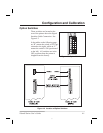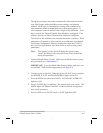
Hardware Control Signal Descriptions
Request To Send (RTS) is a Control Signal from the S-Series Printer to
the host computer. RTS is always in the ACTIVE condition (positive
voltage) whenever the printer is powered ON.
Data Set Ready (DSR) is a control signal from the host computer to the
printer. When DSR is in the ACTIVE condition (positive voltage), the
printer can transmit status to the host. When CTS is in the INACTIVE
condition (negative voltage), the printer will not transmit any data.
When DTR/DSR handshaking is selected, via DIP Switch #7 at the rear
of the printer, the Data Terminal Ready (DTR) Control Signal output
from the printer controls when the host computer may send data. DTR
ACTIVE (Positive voltage), permits the host to send data. When the
printer places DTR in the INACTIVE (negative voltage) state, the host
must not send data.
Note: When XON/XOFF handshaking is selected, data flow is
controlled by the ASCII Control Codes DC1 (XON) and DC3
(XOFF). The DTR Control lead will have no effect.
RS-232 Cabling Requirements
The required cable must have a 25-pin “D” Type (DB25P) male con-
nector on one end, which is plugged into the mating (DB25S) female
connector located at the upper rear of the printer. Tighten the locking
screws.
The other end of the Signal Interface Cable connects to an appropriate
point at the host computer. This cable will be one of two types depend-
ing on the specific interface requirements. Refer to the following pages
for information on the standard and null modem cables.
Data cables must be fully shielded and fitted with metal or metallized
connector shells. Shielded cables and connectors are required to pre-
vent radiation and reception of electrical noise.
Zebra S-Series User’s Guide 5-3
61


















